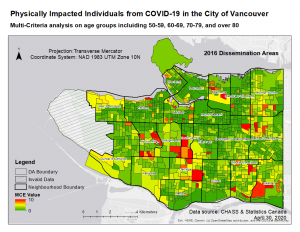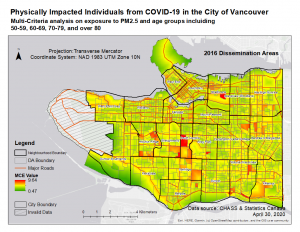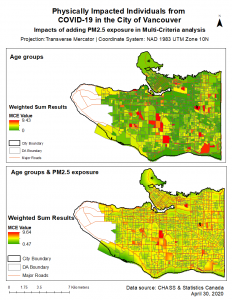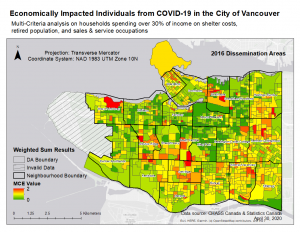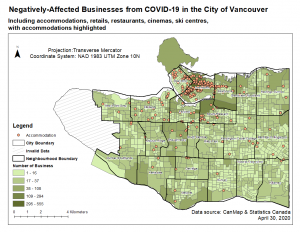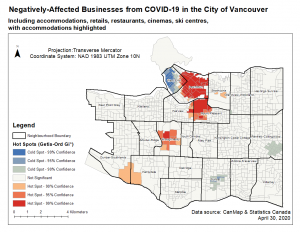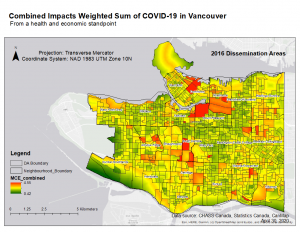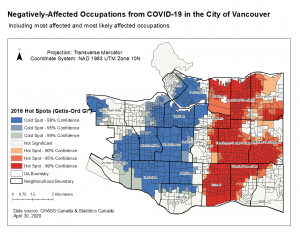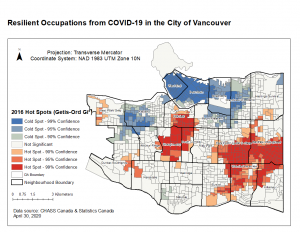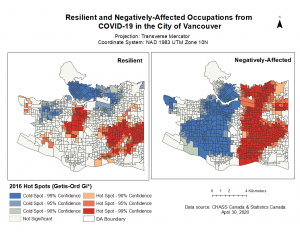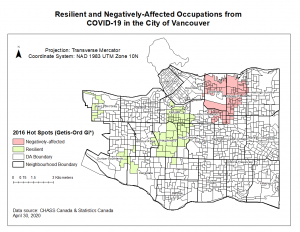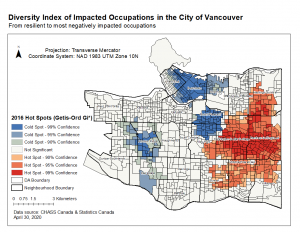MCE for Age Groups
The first weighted MCE results we did visualize DAs that are more physically at-risk by looking at the mortality rate of people of different ages after infection with the virus. The population was divided into four groups aged 50-59, 60-69, 70-79 and over 80. According to New York Health (Worldometer, 2000), the age group over 80 years old was considered most likely to die from COVID-19. In decreasing order, it was followed by 70-79, 60-69, and 50-59. AHP calculator, therefore, weighed each of the factors based on the mortality rate of each age group.
The results of this MCE were shown in the first map. The MCE values of each factor range from 0 to 10. In the text, we referred to red areas on the map as very high, which means that the risk of death of COVID-19 was very high, while the yellow and green areas are medium and very low, respectively.
According to the MCE model, the physically high-risk areas are identified, and they are mainly located in central Vancouver. The very high values of MCE represent that people in these DAs are more likely to die from COVID-19, which is determined by demographic characteristics — for example, a high proportion of the elderly. These DAs are particularly concentrated in communities such as South Cambie and Shaughnessy. A second area at risk was identified in the southeast, where communities like Killarney contain DAs with very high MCE values. A third region which has identical DAs with high MCE value is in the northeast of Vancouver. The DA in Strathcona has a particularly high MCE value compared with its surrounding DAs. By looking at the open street map, we found a very large care house (Villa Cathay care Home) in this DA, which may be the reason for the high MCE value.
The DAs identified as medium risk (orange and yellow) by the MCE model were mostly located in regions around high-risk DAs. They are clustered in communities including Oakridge, Renfrew-Collingwood and Killarney. We noticed that West Point Grey and Dunbar-Southlands also have quite a few DAs ranked as medium risk. The low-risk DAs cover most of Vancouver. Downtown, Mount Pleasant and Grandview-Woodland seem to be the most resistant neighbourhoods to COVID-19.
MCE for Age Groups and PM2.5 Exposure
Since the above weighted MCE analysis only takes into account the risk of death from COVID-19 for different ages, we therefore carried out a more complex MCE analysis that included residents’ exposure to PM2.5 (the map below). In the second MCE model, seniors over 80 and exposure to an increase of 1ug/m3 PM2.5 contributed to the highest mortality rate, and thus DAs with more seniors over 80 as well as having long-term exposure to an increasing PM2.5 concentration would be identified as high risk. The order of the remaining factors is the same as that of the first MCE pattern.
In contrast to the first MCE model, the second model shows that the majority of DAs in Vancouver are identified as medium risk. In addition, there is more variation in each DA, as we can observe that areas closer to the main traffic route show higher risks than areas farther away from the main traffic route.
The last map compares the results of the two MCE models mentioned above. It is interesting to note that in the second MCE model, fewer DAs are identified as high risks, such as the DA on the southeast corner, which was listed as high risk in the first MCE model, and is now in the middle to low-risk range. In other words, the mortality risk of COVID-19 in this DA was reduced, and PM2.5 exposure should be an important factor leading to this result. On the other hand, two areas, South Cambie and Strathcona are still considered at very high risk.
